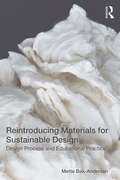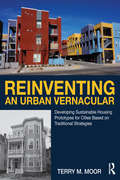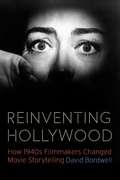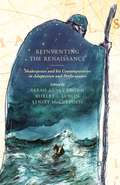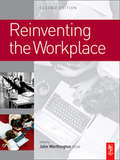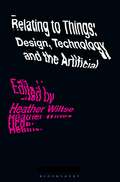- Table View
- List View
Reinforced Concrete Designer's Handbook
by Charles E. Reynolds James C. Steedman Anthony J. ThrelfallThis classic and essential work has been thoroughly revised and updated in line with the requirements of new codes and standards which have been introduced in recent years, including the new Eurocode as well as up-to-date British Standards. It provides a general introduction along with details of analysis and design of a wide range of structures and examination of design according to British and then European Codes. Highly illustrated with numerous line diagrams, tables and worked examples, Reynolds's Reinforced Concrete Designer's Handbook is a unique resource providing comprehensive guidance that enables the engineer to analyze and design reinforced concrete buildings, bridges, retaining walls, and containment structures. Written for structural engineers, contractors, consulting engineers, local and health authorities, and utilities, this is also excellent for civil and architecture departments in universities and FE colleges.
Reintegrating Severance: Interdisciplinary Insights on Apple TV’s Dystopian Thriller
by Jennifer Dawes Nora M. IsacoffThis edited collection is an interdisciplinary examination of Apple TV's Severance, in which employees of a biotech firm consent to having their brains severed so that their work selves and non-work selves do not retain each other’s memories. What transpires is a reckoning with the very nature of the self, consciousness, and memory, through a series steeped in explorations of capitalism, social welfare, and bioethics. Chapters in this book examine the popularity and critical acclaim surrounding the show; its retrofuturistic asethetic; its commentary on popular culture and identity; and its engagement with nostalgia, among other topics.
Reintroducing Materials for Sustainable Design: Design Process and Educational Practice
by Mette Bak-AndersenReintroducing Materials for Sustainable Design provides instrumental theory and practical guidance to bring materials back into a central role in the design process and education. To create designs that are sustainable and respond to current environmental, economic and cultural concerns, practitioners and educators require a clear framework for materials use in design and product manufacturing. While much has been written about sustainable design over the last two decades, outlining systems of sustainability and product criteria, to design for material circularity requires a detailed understanding of the physical matter that constitutes products. Designers must not just know of materials but know how to manipulate them and work with them creatively. This book responds to the gap by offering a way to acquire the material knowledge necessary to design physical objects for sustainability. It reinforces the key role and responsibility of designers and encourages designers to take back control over the ideation and manufacturing process. Finally, it discusses the educational practice involved and the potential implications for design education following implementation, addressing didactics, facilities and expertise. This guide is a must-read for designers, educators and researchers engaged in sustainable product design and materials.
Reintroducing Materials for Sustainable Design: Design Process and Educational Practice
by Mette Bak-AndersenReintroducing Materials for Sustainable Design provides instrumental theory and practical guidance to bring materials back into a central role in the design process and education. To create designs that are sustainable and respond to current environmental, economic and cultural concerns, practitioners and educators require a clear framework for materials use in design and product manufacturing. While much has been written about sustainable design over the last two decades, outlining systems of sustainability and product criteria, to design for material circularity requires a detailed understanding of the physical matter that constitutes products. Designers must not just know of materials but know how to manipulate them and work with them creatively. This book responds to the gap by offering a way to acquire the material knowledge necessary to design physical objects for sustainability. It reinforces the key role and responsibility of designers and encourages designers to take back control over the ideation and manufacturing process. Finally, it discusses the educational practice involved and the potential implications for design education following implementation, addressing didactics, facilities and expertise. This guide is a must-read for designers, educators and researchers engaged in sustainable product design and materials.
Reinventing an Urban Vernacular: Developing Sustainable Housing Prototypes for Cities Based on Traditional Strategies
by Terry MoorWith increasing population and its associated demand on our limited resources, we need to rethink our current strategies for construction of multifamily buildings in urban areas. Reinventing an Urban Vernacular addresses these new demands for smaller and more efficient housing units adapted to local climate. In order to find solutions and to promote better urban communities with an overall environmentally responsible lifestyle, this book examines a wide variety of vernacular building precedents, as they relate to the unique characteristics and demands of six distinctly different regions of the United States. Terry Moor addresses the unique landscape, climate, physical, and social development by analyzing vernacular precedents, and proposing new suggestions for modern needs and expectations. Written for students and architects, planners, and urban designers, Reinventing an Urban Vernacular marries the urban vernacular with ongoing sustainability efforts to produce a unique solution to the housing needs of the changing urban environment.
Reinventing an Urban Vernacular: Developing Sustainable Housing Prototypes for Cities Based on Traditional Strategies
by Terry MoorWith increasing population and its associated demand on our limited resources, we need to rethink our current strategies for construction of multifamily buildings in urban areas. Reinventing an Urban Vernacular addresses these new demands for smaller and more efficient housing units adapted to local climate. In order to find solutions and to promote better urban communities with an overall environmentally responsible lifestyle, this book examines a wide variety of vernacular building precedents, as they relate to the unique characteristics and demands of six distinctly different regions of the United States. Terry Moor addresses the unique landscape, climate, physical, and social development by analyzing vernacular precedents, and proposing new suggestions for modern needs and expectations. Written for students and architects, planners, and urban designers, Reinventing an Urban Vernacular marries the urban vernacular with ongoing sustainability efforts to produce a unique solution to the housing needs of the changing urban environment.
Reinventing Civil Society: The Emerging Role of Faith-Based Organizations
by Cynthia Jackson-Elmoore Richard C. Hula Laura A. ReeseThis guide concentrates on resources that are useful, in an easy-to-use format to enable architects, designers and engineers to access a wealth of knowledge. Information allows users to find, evaluate and contact the resources that can save time and money in day-to-day practice.
Reinventing Civil Society: The Emerging Role of Faith-Based Organizations
by Cynthia Jackson-Elmoore Richard C. Hula Laura A. ReeseThis guide concentrates on resources that are useful, in an easy-to-use format to enable architects, designers and engineers to access a wealth of knowledge. Information allows users to find, evaluate and contact the resources that can save time and money in day-to-day practice.
Reinventing Hollywood: How 1940s Filmmakers Changed Movie Storytelling
by David BordwellIn the 1940s, American movies changed. Flashbacks began to be used in outrageous, unpredictable ways. Soundtracks flaunted voice-over commentary, and characters might pivot from a scene to address the viewer. Incidents were replayed from different characters’ viewpoints, and sometimes those versions proved to be false. Films now plunged viewers into characters’ memories, dreams, and hallucinations. Some films didn’t have protagonists, while others centered on anti-heroes or psychopaths. Women might be on the verge of madness, and neurotic heroes lurched into violent confrontations. Combining many of these ingredients, a new genre emerged—the psychological thriller, populated by women in peril and innocent bystanders targeted for death. If this sounds like today’s cinema, that’s because it is. In Reinventing Hollywood, David Bordwell examines the full range and depth of trends that crystallized into traditions. He shows how the Christopher Nolans and Quentin Tarantinos of today owe an immense debt to the dynamic, occasionally delirious narrative experiments of the Forties. Through in-depth analyses of films both famous and virtually unknown, from Our Town and All About Eve to Swell Guy and The Guilt of Janet Ames, Bordwell assesses the era’s unique achievements and its legacy for future filmmakers. Reinventing Hollywood is a groundbreaking study of how Hollywood storytelling became a more complex art and essential reading for lovers of popular cinema.
Reinventing Hollywood: How 1940s Filmmakers Changed Movie Storytelling
by David BordwellIn the 1940s, American movies changed. Flashbacks began to be used in outrageous, unpredictable ways. Soundtracks flaunted voice-over commentary, and characters might pivot from a scene to address the viewer. Incidents were replayed from different characters’ viewpoints, and sometimes those versions proved to be false. Films now plunged viewers into characters’ memories, dreams, and hallucinations. Some films didn’t have protagonists, while others centered on anti-heroes or psychopaths. Women might be on the verge of madness, and neurotic heroes lurched into violent confrontations. Combining many of these ingredients, a new genre emerged—the psychological thriller, populated by women in peril and innocent bystanders targeted for death. If this sounds like today’s cinema, that’s because it is. In Reinventing Hollywood, David Bordwell examines the full range and depth of trends that crystallized into traditions. He shows how the Christopher Nolans and Quentin Tarantinos of today owe an immense debt to the dynamic, occasionally delirious narrative experiments of the Forties. Through in-depth analyses of films both famous and virtually unknown, from Our Town and All About Eve to Swell Guy and The Guilt of Janet Ames, Bordwell assesses the era’s unique achievements and its legacy for future filmmakers. Reinventing Hollywood is a groundbreaking study of how Hollywood storytelling became a more complex art and essential reading for lovers of popular cinema.
Reinventing Hollywood: How 1940s Filmmakers Changed Movie Storytelling
by David BordwellIn the 1940s, American movies changed. Flashbacks began to be used in outrageous, unpredictable ways. Soundtracks flaunted voice-over commentary, and characters might pivot from a scene to address the viewer. Incidents were replayed from different characters’ viewpoints, and sometimes those versions proved to be false. Films now plunged viewers into characters’ memories, dreams, and hallucinations. Some films didn’t have protagonists, while others centered on anti-heroes or psychopaths. Women might be on the verge of madness, and neurotic heroes lurched into violent confrontations. Combining many of these ingredients, a new genre emerged—the psychological thriller, populated by women in peril and innocent bystanders targeted for death. If this sounds like today’s cinema, that’s because it is. In Reinventing Hollywood, David Bordwell examines the full range and depth of trends that crystallized into traditions. He shows how the Christopher Nolans and Quentin Tarantinos of today owe an immense debt to the dynamic, occasionally delirious narrative experiments of the Forties. Through in-depth analyses of films both famous and virtually unknown, from Our Town and All About Eve to Swell Guy and The Guilt of Janet Ames, Bordwell assesses the era’s unique achievements and its legacy for future filmmakers. Reinventing Hollywood is a groundbreaking study of how Hollywood storytelling became a more complex art and essential reading for lovers of popular cinema.
Reinventing Hollywood: How 1940s Filmmakers Changed Movie Storytelling
by David BordwellIn the 1940s, American movies changed. Flashbacks began to be used in outrageous, unpredictable ways. Soundtracks flaunted voice-over commentary, and characters might pivot from a scene to address the viewer. Incidents were replayed from different characters’ viewpoints, and sometimes those versions proved to be false. Films now plunged viewers into characters’ memories, dreams, and hallucinations. Some films didn’t have protagonists, while others centered on anti-heroes or psychopaths. Women might be on the verge of madness, and neurotic heroes lurched into violent confrontations. Combining many of these ingredients, a new genre emerged—the psychological thriller, populated by women in peril and innocent bystanders targeted for death. If this sounds like today’s cinema, that’s because it is. In Reinventing Hollywood, David Bordwell examines the full range and depth of trends that crystallized into traditions. He shows how the Christopher Nolans and Quentin Tarantinos of today owe an immense debt to the dynamic, occasionally delirious narrative experiments of the Forties. Through in-depth analyses of films both famous and virtually unknown, from Our Town and All About Eve to Swell Guy and The Guilt of Janet Ames, Bordwell assesses the era’s unique achievements and its legacy for future filmmakers. Reinventing Hollywood is a groundbreaking study of how Hollywood storytelling became a more complex art and essential reading for lovers of popular cinema.
Reinventing Hollywood: How 1940s Filmmakers Changed Movie Storytelling
by David BordwellIn the 1940s, American movies changed. Flashbacks began to be used in outrageous, unpredictable ways. Soundtracks flaunted voice-over commentary, and characters might pivot from a scene to address the viewer. Incidents were replayed from different characters’ viewpoints, and sometimes those versions proved to be false. Films now plunged viewers into characters’ memories, dreams, and hallucinations. Some films didn’t have protagonists, while others centered on anti-heroes or psychopaths. Women might be on the verge of madness, and neurotic heroes lurched into violent confrontations. Combining many of these ingredients, a new genre emerged—the psychological thriller, populated by women in peril and innocent bystanders targeted for death. If this sounds like today’s cinema, that’s because it is. In Reinventing Hollywood, David Bordwell examines the full range and depth of trends that crystallized into traditions. He shows how the Christopher Nolans and Quentin Tarantinos of today owe an immense debt to the dynamic, occasionally delirious narrative experiments of the Forties. Through in-depth analyses of films both famous and virtually unknown, from Our Town and All About Eve to Swell Guy and The Guilt of Janet Ames, Bordwell assesses the era’s unique achievements and its legacy for future filmmakers. Reinventing Hollywood is a groundbreaking study of how Hollywood storytelling became a more complex art and essential reading for lovers of popular cinema.
Reinventing Hollywood: How 1940s Filmmakers Changed Movie Storytelling
by David BordwellIn the 1940s, American movies changed. Flashbacks began to be used in outrageous, unpredictable ways. Soundtracks flaunted voice-over commentary, and characters might pivot from a scene to address the viewer. Incidents were replayed from different characters’ viewpoints, and sometimes those versions proved to be false. Films now plunged viewers into characters’ memories, dreams, and hallucinations. Some films didn’t have protagonists, while others centered on anti-heroes or psychopaths. Women might be on the verge of madness, and neurotic heroes lurched into violent confrontations. Combining many of these ingredients, a new genre emerged—the psychological thriller, populated by women in peril and innocent bystanders targeted for death. If this sounds like today’s cinema, that’s because it is. In Reinventing Hollywood, David Bordwell examines the full range and depth of trends that crystallized into traditions. He shows how the Christopher Nolans and Quentin Tarantinos of today owe an immense debt to the dynamic, occasionally delirious narrative experiments of the Forties. Through in-depth analyses of films both famous and virtually unknown, from Our Town and All About Eve to Swell Guy and The Guilt of Janet Ames, Bordwell assesses the era’s unique achievements and its legacy for future filmmakers. Reinventing Hollywood is a groundbreaking study of how Hollywood storytelling became a more complex art and essential reading for lovers of popular cinema.
Reinventing Print: Technology and Craft in Typography
by David JuryWith the rise of digital technology as a design tool and its acceptance as simply part of the tool chest for today's design studios, there has been a re-evaluation and return to exploring pre-digital typography.Design studios no longer flaunt their digital hardware, in fact quite the opposite. This attitudinal change toward digital technology has coincided with a growing fascination and re-evaluation of those pre-digital skills and processes that had been considered in recent years to be irrelevant. Mapping the rise of digital technology and examining the infinite possibilities it offers and the profound cultural and technical influence it has had in all aspects of visual communication. This text also focuses on our current post-digital age, in which the technology itself has become sufficiently common-place for us to fully recognize what it excels at and what it does less well.Reinventing Print focuses on those skills and processes which have been re-appropriated and irreverently liberated by a new generation of typographers, designers, and artists, raised with digital technology in their pockets and forever at their fingertips. In this post-digital age, traditional typographic craft is new, different and therefore exciting, potent and culturally subversive.
Reinventing Print: Technology and Craft in Typography
by David JuryWith the rise of digital technology as a design tool and its acceptance as simply part of the tool chest for today's design studios, there has been a re-evaluation and return to exploring pre-digital typography.Design studios no longer flaunt their digital hardware, in fact quite the opposite. This attitudinal change toward digital technology has coincided with a growing fascination and re-evaluation of those pre-digital skills and processes that had been considered in recent years to be irrelevant. Mapping the rise of digital technology and examining the infinite possibilities it offers and the profound cultural and technical influence it has had in all aspects of visual communication. This text also focuses on our current post-digital age, in which the technology itself has become sufficiently common-place for us to fully recognize what it excels at and what it does less well.Reinventing Print focuses on those skills and processes which have been re-appropriated and irreverently liberated by a new generation of typographers, designers, and artists, raised with digital technology in their pockets and forever at their fingertips. In this post-digital age, traditional typographic craft is new, different and therefore exciting, potent and culturally subversive.
Reinventing the Chicken Coop: 14 Original Designs with Step-by-Step Building Instructions
by Kevin McElroy Matthew WolpeThe step-by-step instructions and full-color photographs of these inspiring coops will delight both first-time builders and veteran chicken farmers alike.
Reinventing the Renaissance: Shakespeare and his Contemporaries in Adaptation and Performance
by Sarah Annes Brown, Robert I. Lublin and Lynsey McCullochThe plays of Shakespeare and his contemporaries has inspired interpretations in every genre and medium. This book offers perspectives on the ways in which practitioners have used Renaissance drama to address contemporary concerns and reach new audiences. It provides a resource for those interested in the creative reception of Renaissance drama.
Reinventing the Workplace
by John WorthingtonIncorporating a diversity of practices, cultural and organization change, and new building forms, this book provides ideas, inspiration and analysis of the multitude of ways in which an office space can be designed and utilized. Updated to cope with technological advances, as well as including a new series of case studies on recent Australian, North American and Scandinavian experiences, the contributors draw on a wealth and variety of professional experience to present the best and most innovative solutions for today's office - and tomorrow's workplace.
Reinventing the Workplace
by John WorthingtonIncorporating a diversity of practices, cultural and organization change, and new building forms, this book provides ideas, inspiration and analysis of the multitude of ways in which an office space can be designed and utilized. Updated to cope with technological advances, as well as including a new series of case studies on recent Australian, North American and Scandinavian experiences, the contributors draw on a wealth and variety of professional experience to present the best and most innovative solutions for today's office - and tomorrow's workplace.
The Reinvention of Distinction: Modernity and the Middle Class in Urban Vietnam (ARI - Springer Asia Series #2)
by Van Nguyen-Marshall, Lisa B. Welch Drummond and Danièle BélangerThis pioneering collection brings together an international group of scholars to explore the Vietnamese middle class. From the leisure pursuits of the colonial middle class to the impact of the new urban rich on landscape of the countryside, this interdisciplinary volume explores the ways in which middle classness has been practiced in a wide range of contexts throughout the 20th century and into the 21st. In addition to offering insights into how middle classness was and is constituted and negotiated, this collection illuminates the cultural and social conditions of two distinctive periods in Vietnamese history. Three historical chapters consider how middle class status was experienced and displayed under French colonialism and in 1960s republican. These chapters offer examinations of middle classness through recreation, consumption, and associational life. Six contemporary studies examine the modes of experimentation and practice within middle class urban Vietnam. Still a sensitive topic politically, the contemporary middle class, nascent but increasingly powerful, is exerting a strong impact on the shape of contemporary society and culture, as well as on urban and rural landscapes. This volume offers a series of studies which critically interrogate the practices of those who engage in or aspire to urban middle-class lifestyles in Vietnam both in the past and in the present.
Reise ins bekannte Fremde: Ausstellungen japanischer Holzschnitte im Westen vom späten 19. Jahrhundert bis in die Gegenwart (Image #241)
by Marina SammeckJapanische Holzschnitte (ukiyo-e) zählen heute zu den berühmtesten Kunstformen Ostasiens. Doch wie haben die Drucke aus der Edo-Zeit diesen Status erhalten? Als Ursprung für ihren Weltruhm wird häufig auf die Japonismus-Epoche Ende des 19. Jahrhunderts verwiesen. Dabei blenden Kunstwissenschaft und Museumswelt aus, dass die Drucke in den letzten siebzig Jahren vielfach präsentiert wurden. Marina Sammeck verfolgt, wie japanische Holzschnitte durch Ausstellungen und Allianzen zu einer der populärsten japanischen Kunstformen im Westen aufsteigen konnten. Im Mittelpunkt ihrer Analyse steht die Beschreibung des Prozesses, in dem spezifische Objekte zu »Kunst« werden - und was dieser für die zukünftige Ausstellungspraxis bedeutet.
Rekonstruktionen von Subjektnormen und Subjektivierungen: Eine qualitative Studie über Lifestyle-Normen und deren Relevanz für YouTuber (Film und Bewegtbild in Kultur und Gesellschaft)
by Daniel BurghardtAnhand detaillierter Analysen von YouTube-Videos verdeutlicht das Buch, welch zentrale Rolle Subjektnormen für verschiedene Produzent_innen von Lifestyle-Videos spielen. Hierbei werden sowohl unterschiedliche Normen sichtbar, als auch deren Relationen zum Habitus der Untersuchten, welche sich in Aneignungs-, Passungs- und Spannungsverhältnissen sowie in Widersetzungen ausdrücken. Im Kontext der Subjektivierungsforschung und deren Bezugnahme auf Althusser und Foucault lassen sich jene Ausrichtungen als Subjektivierungen deuten, die mal mehr, mal weniger reflektiert vollzogen werden.
Relating to Things: Design, Technology and the Artificial
by Heather WiltseWe relate to things and things relate to us. Emerging technologies do this in ways that are interesting and exciting, but often also inaccessible or invisible. In Relating to Things, leading design researchers and philosophers respond to issues raised by this situation - inquiring into what it means to live with and relate to things that can actively relate to us, and that relate to each other in ways that do not involve us at all.Case studies include Amazon's Alexa, the Internet of Things, Pokémon Go and Roomba the robot vacuum cleaner. Authors explore everything from the care work undertaken by objects, reciprocal human/machine learning, technological mediation as a form of control, and what it takes to reveal things that tend to be hidden and that often (by design) conceal the ways in which they use us.As a whole, the book is a collaborative philosophical inquiry into the nature and consequences of contemporary technological things. It is a design inquiry into the current nature of the artificial, and possibilities for how things might be otherwise.
Relating to Things: Design, Technology and the Artificial
We relate to things and things relate to us. Emerging technologies do this in ways that are interesting and exciting, but often also inaccessible or invisible. In Relating to Things, leading design researchers and philosophers respond to issues raised by this situation - inquiring into what it means to live with and relate to things that can actively relate to us, and that relate to each other in ways that do not involve us at all.Case studies include Amazon's Alexa, the Internet of Things, Pokémon Go and Roomba the robot vacuum cleaner. Authors explore everything from the care work undertaken by objects, reciprocal human/machine learning, technological mediation as a form of control, and what it takes to reveal things that tend to be hidden and that often (by design) conceal the ways in which they use us.As a whole, the book is a collaborative philosophical inquiry into the nature and consequences of contemporary technological things. It is a design inquiry into the current nature of the artificial, and possibilities for how things might be otherwise.


